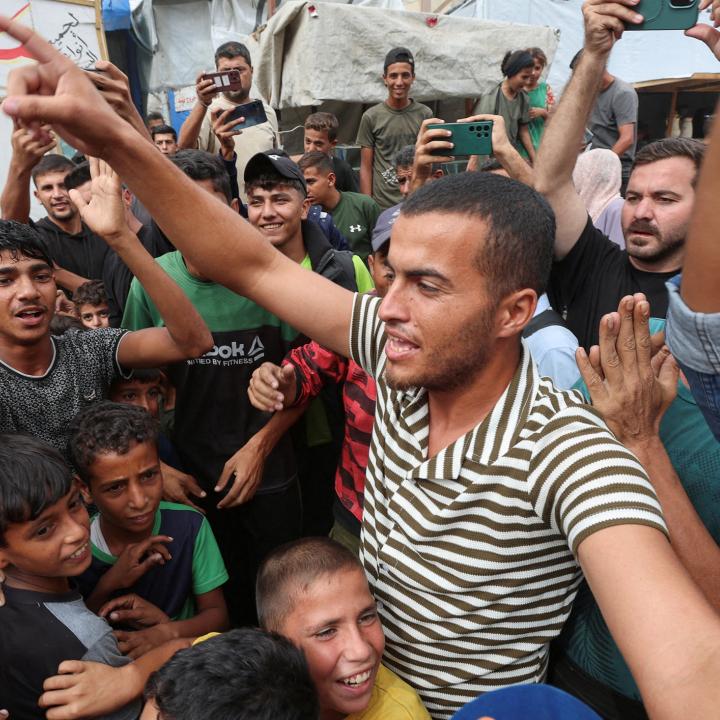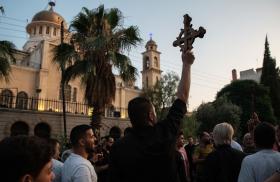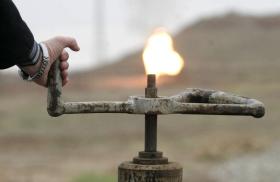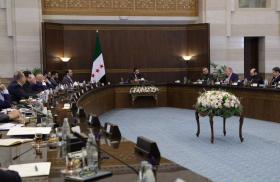
- Policy Analysis
- PolicyWatch 4120
The Gaza "First Phase" Agreement: Assessments and Implications

Five experts and former high-level officials discuss the gamut of opportunities and risks created by the Trump administration’s diplomatic achievement.
On October 10, The Washington Institute held a Policy Forum with Michael Herzog, Ghaith al-Omari, David Makovsky, Neomi Neumann, and Nickolay Mladenov. Michael Herzog is the Tisch Distinguished Fellow at The Washington Institute and a retired IDF brigadier general who served as Israel’s ambassador to the United States from 2021 to 2025. Ghaith al-Omari is the Institute’s Gilbert Foundation Senior Fellow and a former advisor to the Palestinian negotiating team during the 1999–2001 permanent-status talks. David Makovsky is the Ziegler Distinguished Fellow at the Institute and a former advisor to the State Department’s special envoy for Israeli-Palestinian negotiations. Neomi Neumann, a former visiting fellow at the Institute (2023–25) whose work focused on Palestinian affairs, previously led the research unit of the Israel Security Agency. Nickolay Mladenov is the Institute’s Segal Distinguished Visiting Fellow and director-general of the UAE’s Anwar Gargash Diplomatic Academy. The following is a rapporteur’s summary of their remarks.
Michael Herzog
Intense joy and relief are pulsing through Israel in anticipation of the planned release of the hostages. The hostage issue has become an open wound in Israeli society, and their return could enable the start of a healing process.
What made this deal possible, unlike previous efforts? The Trump administration realized that circumstances had ripened on both sides, seized the moment, and locked the parties into the deal with a well-calculated mix of carrots and sticks, convincing them that they would be worse off continuing the war. Critically, mediators got the plan rolling by focusing on phase one, covering immediate concerns including a ceasefire, the release of hostages, and Israel Defense Forces redeployment and the release of Palestinian prisoners—while delaying until later stages more contentious issues (e.g., disarming Hamas and removing the group from power).
The U.S. plan found Hamas weakened by ongoing Israeli military pressure and facing the threat of a broader offensive on its Gaza City stronghold. To this the United States added intense political pressure from a united Arab and Muslim front, specifically Qatar and Turkey, alongside the incentive of an end-of-war announcement while leaving open the next phases.
For Israel, the Trump plan offers a way out of its predicament. Two years into the war, Israel realized that its main war goals—defeating Hamas militarily and politically and releasing all the hostages—could not be achieved simultaneously and might take a long time. In the meanwhile, the prolonged war has exacted an exceedingly high price: a strained society divided over the war’s direction and an unprecedented loss of global standing. Amid the fierce internal debate over the war’s priorities, the current agreement aligns with the views of most Israelis: freeing the hostages first and completing the dismantling of Hamas later. The government could subscribe to this approach because the deal released up-front all the hostages, or at least those still living, while retaining IDF control over most of Gaza’s territory for the current phase.
Yet major challenges lie ahead in the next phases, including the risk of a slide back into war, requiring a continued hands-on U.S. approach. The Turkish and Qatari roles in implementation also raise concerns due to their support for Hamas and—certainly in Turkey’s case—hostility to Israel. But Israel recognizes their status as strong American partners with leverage over Hamas, highlighting the importance of active involvement from more-aligned Arab partners, such as the United Arab Emirates.
Ghaith al-Omari
The notable absence of representatives from the Palestinian Authority (PA) and aligned Arab partners in the ceasefire talks is neither surprising nor concerning at this early stage. The PA’s lack of diplomatic efforts throughout the Gaza war reflects structural weaknesses that must be addressed through reform and renewal. Revitalizing the PA requires a swift exit for President Mahmoud Abbas, given that many Palestinians view him as corrupt, ineffective, and out of touch. New PA leadership must command with moral clarity, urgency to reform decaying institutions, and efforts to regain trust, while reengaging with the United States and regional partners. Without a strong PA, Hamas will seek to establish itself as the main actor engaged by the international community.
Egypt is planning to hold a Palestinian national dialogue that will cover Gaza governance and Hamas disarmament. But the inclusion of Hamas in these talks underscores the group’s ongoing ability to shape the discourse and remain relevant in the postwar landscape. This highlights the need for actors such as Saudi Arabia and the UAE to be part of the postwar arrangements and exert their influence, counterbalancing Turkey and Qatar, which tend to favor Hamas. U.S. pressure may be required to bring them to the table, given signs of reluctance by those countries to get involved in “day after” arrangements.
David Makovsky
Efforts by President Trump to end the Gaza war succeeded in large part because of consistent polling within Israel suggesting support for efforts to end the war and release the remaining hostages. Yet as a future election looms, Prime Minister Binyamin Netanyahu will seek to project a narrative claiming that the prolonged war effort and recent Gaza City operation—layered with the decapitation of regional enemies—shifted the balance of power in Israel’s favor were the main reasons.
Netanyahu will campaign on his commitment to security rooted in regional successes, his cultivation of the critical partnership with President Trump, and vague promises of Saudi normalization. Meanwhile, his opponents will claim that Trump’s influence was paramount in the negotiations, and that the prime minister could have saved many soldiers’ lives and Israel’s global reputation by accepting an earlier deal that was similar in content.
While the upcoming election will indeed influence Israeli policy in postwar Gaza, a likely early election means Netanyahu will be less constrained than before by the threat of his coalition collapsing. Many questions remain as the ceasefire comes into play, including whether the international force will contribute to Hamas’s disarmament and the scope and timeline of Israel’s withdrawal from Gaza. Israel will likely seek to retain freedom of military action against the group, but details on such matters remain vague at present.
Neomi Neumann
While the ceasefire has halted the fighting in Gaza, it remains unclear whether Hamas is undergoing a fundamental transformation or merely taking a tactical pause to regroup. Hamas is a pragmatic but not moderate movement that turns to politics when armed resistance cannot advance its vision: leading the Palestinian struggle and harm the state of Israel.
Hamas’s recent flexibility in negotiations stemmed from several factors: growing pressure from Israel’s prolonged military campaign, which significantly damaged its military capabilities; fear of a severe public backlash if it were to reject the deal; and a desire to avoid international blame in the event of failed talks, particularly given the pressure applied by the Trump administration and several Arab and Muslim countries—chiefly Turkey and Qatar, which serve as strategic lifelines for the group.
Ultimately, Hamas achieved three main goals in the war: preventing normalization between Israel and Saudi Arabia, garnering broad international support for the Palestinian cause, and securing the release of senior Palestinian prisoners—a development that strengthens the movement’s human infrastructure and furnishes potential future leaders. Beyond these strategic considerations, Hamas, as the sole Palestinian representative at the talks, gained symbolic legitimacy that bolstered its status as the dominant force in Palestinian politics. The absence of PA leader Mahmoud Abbas from the agreement further emphasized Hamas’s position and helped reinforce the narrative that it alone is worthy of leading the Palestinian people on both the regional and world stages.
Nickolay Mladenov
President Trump’s 20-point plan successfully exerted U.S. diplomatic pressure to reach an end to the war. U.S. leadership lent credibility to the process, and the newfound support from a broad Arab and Muslim coalition ensured its success. The plan not only addresses dire humanitarian needs but forms a consensus on seeking new governance in the Gaza Strip within a framework of further regional engagement.
Hamas’s response, however, ignored Israel’s demilitarization and deradicalization demands, underscoring the urgency for the international community to swiftly implement legitimate governance to bolster the ceasefire’s success. Sustained U.S. engagement will be essential, alongside the willingness of European and regional partners to contribute both funds and troops. The most effective way to prevent Hamas’s resurgence is through a UN Security Council resolution establishing a multinational force with a mandate broader than traditional international peacekeeping efforts, rendering it capable of countering insurgencies in Gaza. Countries must move quickly to build a credible security and governance framework before Hamas undermines such progress and regains control.
This summary was prepared by Nava Goldstein and Zack Apt. The Policy Forum series is made possible through the generosity of the Florence and Robert Kaufman Family.






